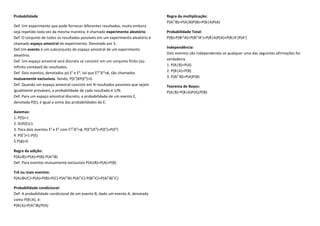Probabilidade Básica
•
0 gostou•1,098 visualizações
1) O documento define termos-chave da probabilidade como experimento aleatório, espaço amostral, evento e define axiomas e regras como a regra da adição e da multiplicação. 2) Regras como a regra da probabilidade total, independência e o teorema de Bayes são explicadas. 3) Conceitos como probabilidade condicional e como calcular a probabilidade de eventos que ocorrem simultaneamente são apresentados.
Denunciar
Compartilhar
Denunciar
Compartilhar
Baixar para ler offline

Recomendados
Mais conteúdo relacionado
Destaque
Destaque (20)
Product Design Trends in 2024 | Teenage Engineerings

Product Design Trends in 2024 | Teenage Engineerings
How Race, Age and Gender Shape Attitudes Towards Mental Health

How Race, Age and Gender Shape Attitudes Towards Mental Health
AI Trends in Creative Operations 2024 by Artwork Flow.pdf

AI Trends in Creative Operations 2024 by Artwork Flow.pdf
Content Methodology: A Best Practices Report (Webinar)

Content Methodology: A Best Practices Report (Webinar)
How to Prepare For a Successful Job Search for 2024

How to Prepare For a Successful Job Search for 2024
Social Media Marketing Trends 2024 // The Global Indie Insights

Social Media Marketing Trends 2024 // The Global Indie Insights
Trends In Paid Search: Navigating The Digital Landscape In 2024

Trends In Paid Search: Navigating The Digital Landscape In 2024
5 Public speaking tips from TED - Visualized summary

5 Public speaking tips from TED - Visualized summary
Google's Just Not That Into You: Understanding Core Updates & Search Intent

Google's Just Not That Into You: Understanding Core Updates & Search Intent
The six step guide to practical project management

The six step guide to practical project management
Beginners Guide to TikTok for Search - Rachel Pearson - We are Tilt __ Bright...

Beginners Guide to TikTok for Search - Rachel Pearson - We are Tilt __ Bright...
Probabilidade Básica
- 1. Probabilidade Regra da multiplicação: P(A∩B)=P(A|B)P(B)=P(B|A)P(A) Def. Um experimento que pode fornecer diferentes resultados, muito embora seja repetido toda vez da mesma maneira, é chamado experimento aleatório. Probabilidade Total: Def. O conjunto de todos os resultados possíveis em um experimento aleatório é P(B)=P(B∩A)+P(B∩A’)=P(B|A)P(A)+P(B|A’)P(A’) chamado espaço amostral do experimento. Denotado por S. Def.Um evento é um subconjunto do espaço amostral de um experimento Independência: Dois eventos são independentes se qualquer uma das seguintes afirmações for aleatório. Def. Um espaço amostral será discreto se consistir em um conjunto finito (ou verdadeira. 1. P(A|B)=P(A) infinito contável) de resultados. 2. P(B|A)=P(B) Def. Dois eventos, denotados pó E¹ e E², tal que E¹∩E²=ǿ, são chamados mutuamente exclusivos. Sendo, P(E¹)XP(E²)=0. 3. P(A∩B)=P(A)P(B) Def. Quando um espaço amostral consistir em N resultados possíveis que sejam Teorema de Bayes: igualmente prováveis, a probabilidade de cada resultado é 1/N. P(A|B)=P(B|A)P(A)/P(B) Def. Para um espaço amostral discreto, a probabilidade de um evento E, denotada P(E), é igual a soma das probabilidades de E. Axiomas: 1. P(S)=1 2. 0≤P(E)≤1 3. Para dois eventos E¹ e E² com E¹∩E²=ǿ, P(E¹UE²)=P(E¹)+P(E²) 4. P(E’)=1‐P(E) 5.P(ǿ)=0 Regra da adição: P(AUB)=P(A)+P(B)‐P(A∩B) Def. Para eventos mutuamente exclusivos P(AUB)=P(A)+P(B) Trê ou mais eventos: P(AUBUC)=P(A)+P(B)+P(C)‐P(A∩B)‐P(A∩C)‐P(B∩C)+P(A∩B∩C) Probabilidade condicional: Def: A probabilidade condicional de um evento B, dado um evento A, denotada como P(B|A), é: P(B|A)=P(A∩B)/P(A)
